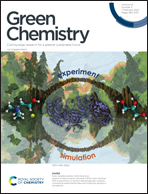Electric production of high-quality fuels via electron beam irradiation under ambient conditions†
Abstract
The production of high-quality fuels and petrochemicals is both energy and emission intensive with traditional methods. The thermal activation of reactions by catalysts or high temperature and pressure or both is very costly, and emits a vast amount of greenhouse gases (GHG). Electric conversion methods using renewable electricity to minimize GHG emissions become more and more necessary. We have now investigated a greener method that uses electron beam irradiation to produce the desired products without any CO2 emissions. Chemical reactions are initiated by collisions between molecules and high energy electrons under ambient conditions. High energy electrons could penetrate the material and effectively deposit energy inside, achieving uniform chemical conversion. Taking advantage of this, new and desirable compounds could be synthesized. Oligomers are the most important product from irradiating liquid hydrocarbons. Straight alkane molecules break down randomly upon irradiation, resulting in broadly distributed iso-paraffins which serve as high-quality fuels. This technology could also effectively convert gaseous hydrocarbons such as propane and isobutane to liquid fuel products with a high concentration of iso-paraffins in a gas to liquid process. This method is electrical and easily adaptable to renewable energy sources with potentially zero GHG emissions.



 Please wait while we load your content...
Please wait while we load your content...